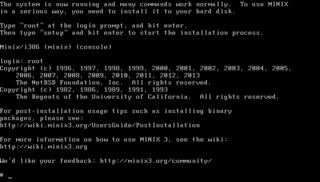Related Research Articles

MINIX is a Unix-like operating system based on a microkernel architecture. Since version 2.0, it has been Portable Operating System Interface (POSIX) compliant.
A monolithic kernel is an operating system architecture where the entire operating system is working in kernel space. The monolithic model differs from other operating system architectures in that it alone defines a high-level virtual interface over computer hardware. A set of primitives or system calls implement all operating system services such as process management, concurrency, and memory management. Device drivers can be added to the kernel as modules.
In computing, a loadable kernel module (LKM) is an object file that contains code to extend the running kernel, or so-called base kernel, of an operating system. LKMs are typically used to add support for new hardware and/or filesystems, or for adding system calls. When the functionality provided by an LKM is no longer required, it can be unloaded in order to free memory and other resources.
Address space layout randomization (ASLR) is a computer security technique involved in preventing exploitation of memory corruption vulnerabilities. In order to prevent an attacker from reliably jumping to, for example, a particular exploited function in memory, ASLR randomly arranges the address space positions of key data areas of a process, including the base of the executable and the positions of the stack, heap and libraries.

ifconfig is a system administration utility in Unix-like operating systems for network interface configuration.

DTrace is a comprehensive dynamic tracing framework originally created by Sun Microsystems for troubleshooting kernel and application problems on production systems in real time. Originally developed for Solaris, it has since been released under the free Common Development and Distribution License (CDDL) in OpenSolaris and its descendant illumos, and has been ported to several other Unix-like systems.
Unix-like operating systems identify a user by a value called a user identifier, often abbreviated to user ID or UID. The UID, along with the group identifier (GID) and other access control criteria, is used to determine which system resources a user can access. The password file maps textual user names to UIDs. UIDs are stored in the inodes of the Unix file system, running processes, tar archives, and the now-obsolete Network Information Service. In POSIX-compliant environments, the command-line command id gives the current user's UID, as well as more information such as the user name, primary user group and group identifier (GID).
Crypto API is a cryptography framework in the Linux kernel, for various parts of the kernel that deal with cryptography, such as IPsec and dm-crypt. It was introduced in kernel version 2.5.45 and has since expanded to include essentially all popular block ciphers and hash functions.
OS-level virtualization is an operating system (OS) paradigm in which the kernel allows the existence of multiple isolated user space instances, called containers, zones, virtual private servers (OpenVZ), partitions, virtual environments (VEs), virtual kernels, or jails. Such instances may look like real computers from the point of view of programs running in them. A computer program running on an ordinary operating system can see all resources of that computer. However, programs running inside of a container can only see the container's contents and devices assigned to the container.
A kernel is a component of a computer operating system. A comparison of system kernels can provide insight into the design and architectural choices made by the developers of particular operating systems.
These tables compare free software / open-source operating systems. Where not all of the versions support a feature, the first version which supports it is listed.

Minix 3 is a small, Unix-like operating system. It is published under a BSD-3-Clause license and is a successor project to the earlier versions, Minix 1 and 2.

Linux is a family of open-source Unix-like operating systems based on the Linux kernel, an operating system kernel first released on September 17, 1991, by Linus Torvalds. Linux is typically packaged as a Linux distribution, which includes the kernel and supporting system software and libraries, many of which are provided by the GNU Project. Many Linux distributions use the word "Linux" in their name, but the Free Software Foundation uses the name "GNU/Linux" to emphasize the use and importance of GNU software in many distributions, causing some controversy.

Kernel-based Virtual Machine (KVM) is a free and open-source virtualization module in the Linux kernel that allows the kernel to function as a hypervisor. It was merged into the mainline Linux kernel in version 2.6.20, which was released on February 5, 2007. KVM requires a processor with hardware virtualization extensions, such as Intel VT or AMD-V. KVM has also been ported to other operating systems such as FreeBSD and illumos in the form of loadable kernel modules.
GNU variants are operating systems based upon the GNU operating system. According to the GNU project and others, these also include most operating systems using the Linux kernel and a few others using BSD-based kernels.
The Berkeley Packet Filter (BPF) is a technology used in certain computer operating systems for programs that need to, among other things, analyze network traffic. It provides a raw interface to data link layers, permitting raw link-layer packets to be sent and received. In addition, if the driver for the network interface supports promiscuous mode, it allows the interface to be put into that mode so that all packets on the network can be received, even those destined to other hosts.

The Linux kernel is a free and open-source, monolithic, modular, multitasking, Unix-like operating system kernel. It was originally written in 1991 by Linus Torvalds for his i386-based PC, and it was soon adopted as the kernel for the GNU operating system, which was written to be a free (libre) replacement for Unix.
NVM Express (NVMe) or Non-Volatile Memory Host Controller Interface Specification (NVMHCIS) is an open, logical-device interface specification for accessing a computer's non-volatile storage media usually attached via the PCI Express bus. The initialism NVM stands for non-volatile memory, which is often NAND flash memory that comes in several physical form factors, including solid-state drives (SSDs), PCIe add-in cards, and M.2 cards, the successor to mSATA cards. NVM Express, as a logical-device interface, has been designed to capitalize on the low latency and internal parallelism of solid-state storage devices.
ftrace is a tracing framework for the Linux kernel. Although its original name, Function Tracer, came from ftrace's ability to record information related to various function calls performed while the kernel is running, ftrace's tracing capabilities cover a much broader range of kernel's internal operations.
References
- 1 2 Bright, Peter (October 28, 2012). "Better on the inside: under the hood of Windows 8". Ars Technica. section "Tick tock".
- ↑ "Linux 2.6.6-rc3". Lwn.net. Retrieved 2015-04-09.
- ↑ "Clockevents and dyntick". Lwn.net. 2007-02-21. Retrieved 2015-04-09.
- ↑ "(Nearly) full tickless operation in 3.10". Lwn.net. Retrieved 2015-04-09.
- ↑ "Bryan Cantrill (former Solaris kernel engineer) comment" . Retrieved 2017-01-07..
- ↑ "What's cooking for FreeBSD 9?".
- ↑ "Tickless Kernel" . Retrieved 25 February 2020.
- ↑ "The MINIX 3 Road Map" . Retrieved 25 February 2020.